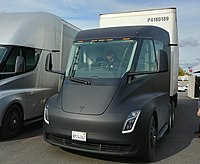
Back Elektrofahrzeug ALS مركبة كهربائية Arabic Електрическо превозно средство Bulgarian বৈদ্যুতিক যানবাহন Bengali/Bangla Vehicle elèctric Catalan ئامرازەکانی گواستنەوەی کارەبایی CKB Elkøretøj Danish Elektrofahrzeug German Ηλεκτροκίνητο όχημα Greek Elektra veturilo Esperanto
This article's lead section may be too long. (December 2023) |
An electric vehicle (EV)[note 1] is one "powered fully or mostly by electricity." It can be powered by a collector system, with electricity from extravehicular sources, or it can be powered autonomously by a battery (sometimes charged by solar panels, or by converting fuel to electricity using fuel cells or a generator).[1] EVs include but are not limited to road and rail vehicles, and broadly can also include electric boat and underwater vessels (submersibles, and technically also diesel- and turbo-electric submarines), electric aircraft and electric spacecraft.
- Electric car, a Mercedes-Benz EQS
- Electric aircraft, the Solar Impulse 2, which circumnavigated the globe
- Electric tram, a Wiener Linien ULF-B in Vienna, Austria
- Battery electric bus, a BYD bus in Landskrona, Sweden
- E-bike in Manhattan, New York City
- Electric truck, Class 8, a Tesla Semi in Rocklin, California
- Electric cart, an Italcar Attiva C2S.4
- Electric boat, the Tûranor PlanetSolar, the first solar-powered boat to circumnavigate the world
Electric road vehicles include electric passenger cars, electric buses, electric trucks and personal transporters such as electric buggy, electric tricycles, electric bicycles and electric motorcycles/scooters. Together with other emerging automotive technologies such as autonomous driving, connected vehicles and shared mobility, EVs form a future vision of transportation called Connected, Autonomous, Shared and Electric (CASE) mobility.[2]
Early electric vehicles first came into existence in the late 19th century, when the Second Industrial Revolution brought forth electrification. Using electricity was among the preferred methods for motor vehicle propulsion as it provides a level of quietness, comfort and ease of operation that could not be achieved by the gasoline engine cars of the time, but range anxiety due to the limited energy storage offered by contemporary battery technologies hindered any mass adoption of private electric vehicles throughout the 20th century. Internal combustion engines (both gasoline and diesel engines) were the dominant propulsion mechanisms for cars and trucks for about 100 years, but electricity-powered locomotion remained commonplace in other vehicle types, such as overhead line-powered mass transit vehicles like electric trains, trams, monorails and trolley buses, as well as various small, low-speed, short-range battery-powered personal vehicles such as mobility scooters. Hybrid electric vehicles, where electric motors are used as a supplementary propulsion to internal combustion engines, became more widespread in the late 1990s. Plug-in hybrid electric vehicles, where electric motors can be used as the predominant propulsion rather than a supplement, did not see any mass production until the late 2000s, and battery electric cars did not become practical options for the consumer market until the 2010s.
Government incentives to increase adoption were first introduced by Norway in 1990, followed by larger markets in the 2000s, including in the United States and the European Union, leading to a growing market for vehicles in the 2010s.[3][4] Increasing public interest and awareness and structural incentives, such as those being built into the green recovery from the COVID-19 pandemic, are expected to greatly increase the electric vehicle market. During the COVID-19 pandemic, lockdowns reduced the number of greenhouse gases in gasoline or diesel vehicles.[5] The International Energy Agency has stated that governments should do more to meet climate goals, including policies for heavy electric vehicles.[6][7] A total of 14% of all new cars sold were electric in 2022, up from 9% in 2021 and less than 5% in 2020.[8] Electric vehicle sales may increase from 1% of the global share in 2016 to more than 35% by 2030.[8][9] As of July 2022 the global EV market size was $280 billion and was expected to grow to $1 trillion by 2026.[10] Much of this growth is expected in markets like North America, Europe, and China;[11] a 2020 literature review suggested that growth in the use of four-wheeled electric vehicles appears economically unlikely in developing economies, but growth in electric two-wheeler and three-wheeler is likely.[12] At more than 20%, two/three-wheelers are already the most electrified road transport segment today, and are projected to continue being the largest EV fleet among all transport modes.[13] Bloomberg reports that in 2023, 292,423,403 bicycles and tricycles sold, representing 49% of the total market. The same report noted that 666,479 buses were sold, with 38% of the market (these are higher priced vehicles, so actual numbers are lower than the percentage of sales), 26,583,856 passenger cars at 14% of sales, and 965,442 vans and trucks with 3% of sales.[14][15]
Cite error: There are <ref group=note> tags on this page, but the references will not show without a {{reflist|group=note}} template (see the help page).
- ^ Asif Faiz; Christopher S. Weaver; Michael P. Walsh (1996). Air Pollution from Motor Vehicles: Standards and Technologies for Controlling Emissions. World Bank Publications. p. 227. ISBN 978-0-8213-3444-7. Archived from the original on 4 July 2021. Retrieved 4 December 2017.
- ^ Hamid, Umar Zakir Abdul (2022). Autonomous, Connected, Electric and Shared Vehicles: Disrupting the Automotive and Mobility Sectors. Retrieved 11 November 2022.
- ^ "FACT SHEET: Obama Administration Announces Federal and Private Sector Actions to Accelerate Electric Vehicle Adoption in the United States". Energy.gov. Archived from the original on 3 June 2021. Retrieved 3 June 2021.
- ^ "EU policy-makers seek to make electric transport a priority". Reuters. 3 February 2015. Archived from the original on 23 February 2017. Retrieved 2 July 2017.
- ^ Transport, Chapter 10 in "Climate Change 2022: Mitigation of Climate Change". www.ipcc.ch. Retrieved 5 April 2022.
- ^ "Global EV Outlook 2021 / Technology Report". IEA.org. International Energy Agency. April 2021. Archived from the original on 29 April 2021.
- ^ IEA (2022), Global EV Outlook 2022, IEA, Paris
- ^ a b "Global EV Outlook 2023 – Data product". IEA. Retrieved 30 June 2023.
- ^ "The electric-vehicle outlook is stronger in China and Europe than in the United States | McKinsey & Company". www.mckinsey.com. Archived from the original on 6 June 2021. Retrieved 6 June 2021.
- ^ "Electric Vehicle (EV) Industry Statistics and Forecasts". EVhype. 30 August 2022. Retrieved 31 October 2022.
- ^ "Electric vehicles". Deloitte Insights. Archived from the original on 6 June 2021. Retrieved 6 June 2021.
- ^ Rajper, Sarmad Zaman; Albrecht, Johan (January 2020). "Prospects of Electric Vehicles in the Developing Countries: A Literature Review". Sustainability. 12 (5): 1906. doi:10.3390/su12051906.
- ^ "Prospects for electric vehicle deployment – Global EV Outlook 2021 – Analysis". IEA. Archived from the original on 29 July 2021. Retrieved 29 July 2021.
- ^ "EVO Report 2023 | BloombergNEF | Bloomberg Finance LP". BloombergNEF. Retrieved 4 December 2023.
- ^ Williams, Jeremy (22 November 2023). "E-bikes are better for the climate than EVs". The Earthbound Report. Retrieved 4 December 2023.
© MMXXIII Rich X Search. We shall prevail. All rights reserved. Rich X Search








